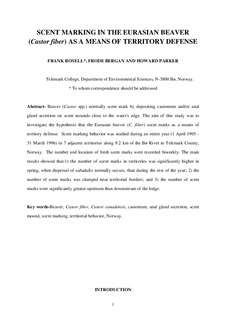| dc.contributor.author | Rosell, Frank | |
| dc.contributor.author | Bergan, Frode | |
| dc.contributor.author | Parker, Howard | |
| dc.date.accessioned | 2007-02-27T11:51:55Z | |
| dc.date.accessioned | 2017-04-19T12:24:56Z | |
| dc.date.available | 2007-02-27T11:51:55Z | |
| dc.date.available | 2017-04-19T12:24:56Z | |
| dc.date.issued | 1998 | |
| dc.identifier.citation | Journal of chemical ecology 23(1998), No. 2, p. 207-219 | |
| dc.identifier.issn | 0098-0331 | |
| dc.identifier.uri | http://hdl.handle.net/11250/2438008 | |
| dc.description.abstract | Beaver (Castor spp.) normally scent mark by depositing castoreum and/or anal gland secretion on scent mounds close to the water's edge. The aim of this study was to investigate the hypothesis that the Eurasian beaver (C. fiber) scent marks as a means of territory defense. Scent marking behavior was studied during an entire year (1 April 1995 - 31 March 1996) in 7 adjacent territories along 9.2 km of the Bø River in Telemark County, Norway. The number and location of fresh scent marks were recorded biweekly. The main results showed that:1) the number of scent marks in territories was significantly higher in spring, when dispersal of subadults normally occurs, than during the rest of the year; 2) the number of scent marks was clumped near territorial borders; and 3) the number of scent marks were significantly greater upstream than downstream of the lodge. | |
| dc.format.extent | 81184 bytes | |
| dc.format.mimetype | application/pdf | |
| dc.language.iso | eng | |
| dc.publisher | Springer | |
| dc.subject | Beavers | |
| dc.subject | Scent marking | |
| dc.subject | Castoreum | |
| dc.subject | Scent mound | |
| dc.subject | Territorial behavior | |
| dc.subject | Anal gland secretion | |
| dc.title | Scent-marking in the Eurasian beaver (Castor fiber) as a means of territory defense | |
| dc.type | Journal article | |
| dc.type | Peer reviewed | |
| dc.subject.nsi | 485 | |
| dc.identifier.doi | http://dx.doi.org/10.1023/A:1022524223435 | |
